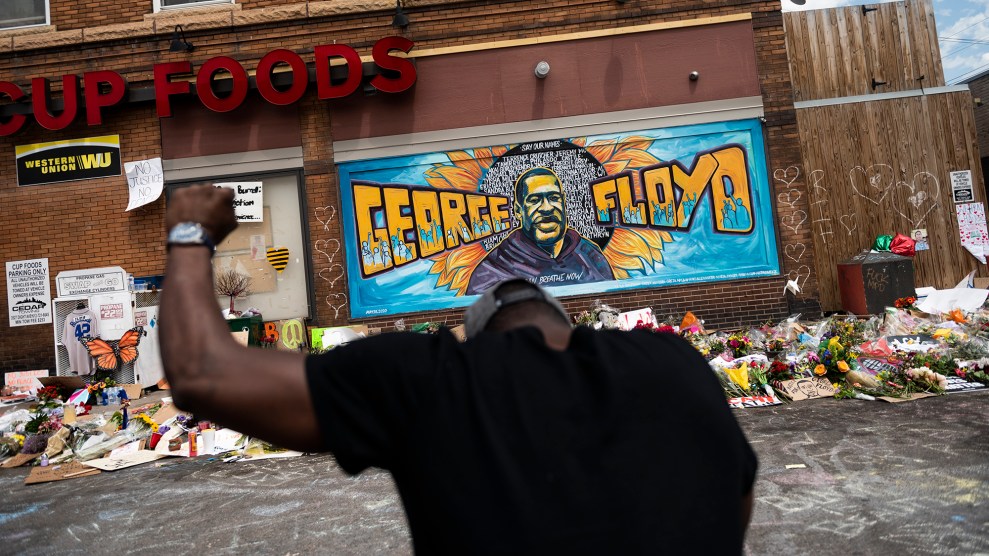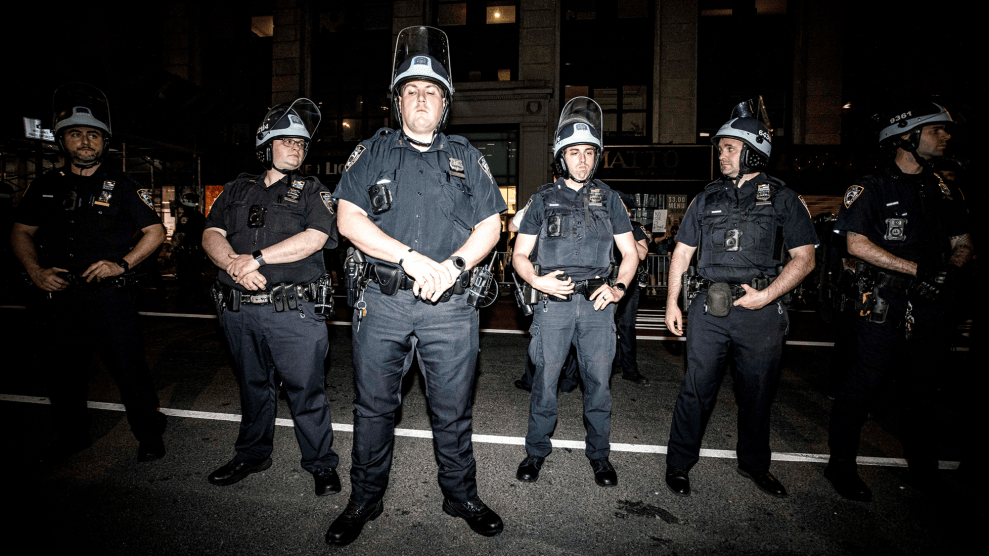
A mural honoring George Floyd in Houston’s Third WardDavid J. Phillip/AP
A day after police officer Derek Chauvin pressed his knee against George Floyd’s neck in Minneapolis, killing him, a county medical examiner began an autopsy. His preliminary findings seemed to conflict with what people had seen in the viral video footage of the May encounter: Though the video showed Floyd repeatedly telling the officer he couldn’t breathe, the examiner wrote that there were no signs Floyd had suffocated. Floyd’s death, the examiner added, was likely due to a combination of his underlying medical conditions, being restrained, and “potential intoxicants” in his system.
It wasn’t the first time a medical examiner or coroner shied away from implicating the police following a high-profile killing. After officers in Colorado restrained 23-year-old Elijah McClain and injected him with ketamine last year, a medical examiner’s office said it couldn’t determine whether McClain died from an accident, natural causes, or a homicide. “The decedent was violently struggling with officers who were attempting to restrain him,” the coroner’s report stated. It added that medics believed McClain had “excited delirium,” a controversial diagnosis that is sometimes applied to people whom police believe are acting manic because of cocaine or other stimulants. (McClain had no history of stimulant drug use, and no such drugs were detected in his body when he was admitted to the hospital, the coroner report noted.) “It is unclear if the officer’s action contributed as well,” the report concluded.
In September, prosecutors in Tucson, Arizona, announced they would not charge police officers in the April death of a 27-year-old man they had restrained naked, handcuffed, and face down on the ground with a spit hood over his head, after a medical examiner’s office found cocaine in his system. The man, Carlos Ingram Lopez, said he couldn’t breathe and repeatedly begged for water, but the medical examiner’s office couldn’t determine whether the officers’ use of restraint had killed him.
In Floyd’s case in Minneapolis, the medical examiner ultimately published the full autopsy report and ruled the death a homicide in June, but only after Floyd’s family paid independent investigators to conduct a second autopsy that concluded asphyxia (suffocation) occurred. And even then, the examiner blamed heart failure, not suffocation, for his death, and noted that fentanyl intoxication and heart disease may have been contributing factors.
Why are coroners often reluctant to implicate police in killings? To find out, I turned to Justin Feldman, a researcher at Harvard’s FXB Center for Health & Human Rights who studies police violence and medical examiners. More often than you might expect, he explained, politicians and police pressure medical examiners to change people’s death certificates, though there’s no public evidence suggesting that happened in the cases of Floyd, McClain, or Lopez.
Coroners also make lots of mistakes—in more than half of cases Feldman studied, they didn’t classify police killings as police killings. And certain medical researchers, along with the company Axon, which produces Tasers, have collectively made it easier for investigators to blame deaths on drugs instead of police force.
Feldman shared with me some little-known truths about medical examiners and revealed simple solutions to fix these problems.
How common is it for a medical examiner to blame drugs after somebody is killed by police?
Specifically when someone dies in police custody but isn’t shot, it’s very common. It’s often attributed to either a drug overdose or this contested medical condition called excited delirium. Sometimes the argument is made that this person would have died anyway.
Can you tell me more about excited delirium?
Excited delirium is a term that a forensic pathologist named Charles Wetli came up with in 1985. The theory behind excited delirium is that someone who uses cocaine or other stimulants chronically over time develops some condition involving the brain that leads them to a state of mania, where they’re violent, they’re not responding to verbal cues, not responding to pain. And in many formulations of people who have described this condition, they say that it in itself is fatal—that the people who are experiencing delirium would have died anyway, even without police restraints or Tasers or chokeholds, or ketamine, which is increasingly being used to treat excited delirium. And they argue there’s some kind of knowable, physiological explanation, but they haven’t actually been able to describe it.
This is a condition that’s not accepted in the International Classification of Diseases, which is the international diagnostic list of all known conditions. It’s not accepted in the Diagnostic and Statistical Manual, which is the psychiatric diagnoses list in the US. But it is something that many medical examiners and coroners use to describe these deaths.
You’ve written that the company Taser, now called Axon, made it easier for medical examiners to blame deaths on excited delirium, and harder to suggest they were caused by a police officer’s use of force or restraint.
I wouldn’t pin it all on Taser/Axon. It starts really with this research by Wetli and his colleagues. Then in the early 1990s, there was a series of deaths in police custody in San Diego, and the San Diego Police Department convened a commission of medical researchers and law enforcement experts to review deaths in custody throughout the United States. They popularized the idea that restraint and positional asphyxia are not fatal as such, but either excited delirium kills them, or it makes them more vulnerable to the effects of restraint or positional asphyxia.
Then in the 1990s, Tasers got a lot more popular in law enforcement. Taser has essentially a product defense unit, because Taser gets sued, particularly when people die after being tased. So [the company’s] product defense strategy is to claim excited delirium was the actual cause of death, and it was just a coincidence that [the victim] was tased before death. They have funded research into excited delirium, and funded the same researchers that cast doubt on the existence of positional asphyxia. They pay expert witnesses to testify in cases involving Taser. In some jurisdictions, you can have a coroner’s cause-of-death determination changed if you challenge it in court, and [Taser’s] done that.
And this is still happening now? It wasn’t just in the ’90s?
Not only is it still happening—it’s being spread to other countries. There are people who have accepted considerable funding from Axon who have gone on to countries like the UK, Australia, and Canada and argued that excited delirium is an explanation for deaths in police custody, and it’s sort of taken off in those places as well.
Note: Axon did not respond to a request for comment.
Are medical examiners not aware that legitimate medical organizations say excited delirium is not really a justification?
A lot of medical research in general, and especially forensic science, is often based on faulty assumptions, and there’s some serious limitations. It’s not that the World Health Organization or the American Psychiatric Association have come out and said, “Hey, this isn’t a thing, or this is something you should be really critical of.” And even if they did, there are very few forensic pathologists or medical examiners in the US, and they have a lot of autonomy and a lot of power. Because not a whole lot of people want to do that job. And there’s not a lot of people certified to do that job. And they kind of do what they want to do.
I would attribute some of their openness to accepting excited delirium to their close relationship with police and often not wanting to implicate police in deaths. I think some of it has to do with genuine uncertainties that arise when you conduct a negative autopsy, where there’s no clear physical signs for the cause of death. In the absence of body cam videos and cellphone videos, usually the only kind of evidence as to what happened was from police themselves. So it’s sort of a convenient explanation that arises in genuine settings of uncertainty, but also the relationship of power between police and medical examiners. And medical examiners are sometimes retaliated against or pressured by police or other government officials to change causes of deaths.
What exactly is their relationship with police?
There are two kinds of death investigators in the US: medical examiners and coroners. Medical examiners are physicians. They are appointed. Coroners in general don’t have much medical training. They’re not physicians, and they are usually elected at the county level.
So they work closely with police in their day-to-day job, which involves investigating things like homicide, suicide, and drug overdose, and they are reliant on a close working relationship with police. They don’t want to make the relationship uncomfortable.
There have been cases where there are egregious conflicts of interest, especially in California, where in some counties, the coroner is the sheriff. It’s the same person. There’s this built-in conflict of interest through the relationship. There’s a position statement by the National Association of Medical Examiners that says, when investigating a death in police custody, bring in someone from a different jurisdiction to investigate the death. But in practice that rarely happens.
You mentioned that sometimes medical examiners or coroners are pressured by politicians. Can you tell me more?
About a decade ago, the National Association of Medical Examiners, which is a professional association for forensic pathologists and medical examiners, surveyed their membership. And about 1 in 5 reported being pressured by a public official, which included politicians and also police, to change cause-of-death determinations or manner-of-death determinations. So, manner of death would be: Is it a suicide, homicide, etc.? And then a good proportion of those who reported experiencing pressure also said they were retaliated against if they refused to change the cause or manner of death.
They may be pressured by police to change something that’s accidental to “homicide,” so that it provides stronger evidence in a murder case. And there’s also a lot of politics around whether someone is classified as dying from suicide, because often families don’t want the cause of death, because it’s stigmatized, to be reported as suicide. So there’s a lot going on in terms of conflicts and controversy over how cause and manner of death are classified.
[In the case of George Floyd], I don’t know if there’s any evidence of direct political pressure on that medical examiner. I think that initial report really points to how the examination of the body itself doesn’t necessarily tell the story. And what the medical examiner in Hennepin County was doing was examining all the possible contributing factors except for the police. That was absent from the [preliminary] description, very notably.
Note: A spokesperson for the Hennepin County medical examiner’s office declined to comment to Mother Jones about Floyd’s case but stated that the office “is an independent entity and does not work for the County Attorney or any law enforcement agency.”
You’ve also reported that medical examiners often make mistakes when they’re classifying deaths. How often does that happen?
Yeah. There’s a diagnostic code for when someone is killed by police under the International Classification of Diseases, and it’s called “legal intervention.” When someone’s killed by police, their death certificate is supposed to say that they were killed by police. And then the proper code is applied to the death certificate. But my research has shown that in over 50 percent of cases, police killings are not classified as police killings in the mortality data: They’re instead usually classified as homicides, as if any civilian killed another civilian. So we don’t have good data on police killings.
And if you look specifically at deaths in police custody that don’t involve shootings, the vast majority are not even classified as homicides. Sometimes there’s a missing manner of death, “accidental” or “undetermined.” Sometimes it’s attributed to drugs or mental illness, or heart disease, or respiratory disease. It’s a big mix. You can’t actually code a death certificate as excited delirium, because it’s not recognized. So it’s very hard to figure out what’s going on when it’s a death like George Floyd’s, or like some of the other deaths we’ve been hearing about recently like Elijah McClain.
If someone dies in police custody, if there are no signs on the body that will tell you this person died of asphyxia, meaning they were suffocated to death because they were restrained, the only story you have to go by is the police officer’s.
What are some of the main reforms that should be made to address the problems we’ve discussed, like medical examiners’ lack of independence and their misclassification of deaths?
One is to do exactly what the National Association of Medical Examiners is calling for, which is to require that independent medical examiners, meaning they’re out of the jurisdiction, investigate deaths in police custody. Another one is to put a checkbox on the death certificate that would say “death in police custody or law enforcement custody,” that would indicate not that the officer caused the death, because determining causation is something that’s fraught with controversy, but just flagging it so that it can be identified in statistical analysis and further review.
And then finally, in many health departments throughout the United States, there are maternal mortality review committees. Every time a mother dies in relation to childbirth, a committee of experts gets together to determine exactly what happened, what were the causes—everything from social determinants of health to their particular treatment in the medical system—and make recommendations for what should happen better in the future to prevent situations like that.
I think there should be a death-in-custody review committee at health departments that would bring together various experts and community members and people in criminal justice accountability groups, to thoroughly examine the circumstances of deaths in police custody, so they could be documented well, and so that systems-level reforms could be identified.
Are there any jurisdictions that are undertaking these reforms?
No. There’s a lot of pushback. In 2015, the office of vital statistics at the Colorado Department of Public Health tried to put a checkbox on the death certificate that had “legal intervention” as a manner of death, with “legal intervention” being the official term for when someone dies at the hands of law enforcement. And the coroners didn’t like it, and they essentially got the vital statistics director to take the checkbox off after just a few months. I think there’s a reluctance by health departments to alienate death investigators or law enforcement.
Have we ever seen any big campaigns to boot elected coroners out of office after they misclassified a death in police custody?
This has really flown under the radar, and very few people know about it, even people who are very much plugged into police accountability work. Their role has been seen basically apolitical, even though that’s not true. And I think few people even know what the job entails.
During the Reconstruction era after the Civil War, when more than 1,000 Black politicians were able to take office, there were dozens of Black coroners, and that was seen as an important role to hold. And also in Alabama, the Lowndes County Freedom Organization, which was like a Black alternative to the local Democratic Party, which was like a Dixiecrat party, they ran a slate of candidates, and they ran a coroner who ended up losing, and they educated their constituents about what the coroner even does. So this is something that’s been to a small degree explored in previous political movements but has certainly not been a major part.













